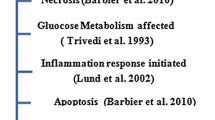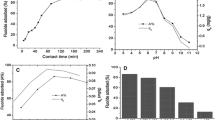Abstract
The paper reports the sorptive responses of a newly developed adsorbent, activated alumina finely grinded with coconut shell powder. The efficiency of the sorption of fluoride ion is affected by pH, contact time, adsorbent dose, type and size of adsorbents. Contact time of mixed bed adsorbent (g/l) increase removal of residual of fluoride from 0.7 to 1.8 mg/l. Optimum pH range 6, (alkalinity range 4 mg/l) is found to reduce fluoride level to 0.8 mg/l.


Similar content being viewed by others
References
World Health Organization. Fluorides and human health (1970) WHO Monogragh series No. 59 Geneva, Switzerland
Srimurali M, Karthikeyan J (2008) Activated alumina: Defluoridation of water and household application. A study. In: Proceedings of the 12th international water technology conference, Alexandria, IWTC 12:1-13, 2008
Venkata Mohan S, Nikhila P, Reddy SJ (1995) Determination of fluoride content in drinking water and development of a model in relation to some water quality parameters. Fresenius Environ Bull 4:297–302
Chaturvedi AK, Yadva KP, Yadava KC, Pathak KC, Singh VN (1990) Deflouridation of water by adsorption on fly ash. Water Air Soil Pollut 49:51–61
Galagan D J, Vermillion J R (1993) Determining optimum fluoride concentrations. Public Health Rep 72. Collect Czech Chem Commun: 491–493
Bone char CL (1968) Carbon, grafite handbook. Interscience Publishers, New York, pp 134–142
Jamode AV, Sapkal VS, Javmode VS (2004) Defluoridation of water using inexpensive adsorbents. J Indian Inst Sci 84:163–171
Bishop PL, Sansoucy G (1978) Fluoride removal from drinking water by fluidized activated alumina adsorption. J Am Water Works Assoc 70:554–559
Frankel I, Juergens E (1980) Removal of fluoride from industrial waste water using activated alumina, EPA-600/2-80-058 U.S. Environmental Production Agency, Office of Research and Development, Washington DC
Maier FJ (1953) Defluoridation of Municiple water supplies. Am J Water Works Assoc 45:879–884
Iyengar L (2001) Report submitted to UNICEF (UNICEF contract no. S&P, 2000/009)
Fink GJ, Lindsay FK (1936) Activated alumina for removing fluorides from drinking water. Ind Eng Chem 28:947–952
Srinivasan PT, Viraraghavan T, Subramanyam KS (1999) Aluminium In drinking water: an overview. Water SA 25:47–50
Gupta VK, Mittal A, Krishnan L, Mittal J (2006) Adsorption treatment and recovery of the hazardous dye, Brilliant Blue FCF, over bottom ash and de-oiled soya. J Colloid Interface Sci 293:16–26
Gupta KG, Ali I, Saini VK (2007) Defluoridation of wastewaters using waste carbon slurry. Water Res 41:3307–3316
Vinod KG, Alok M, Malviya A, Mittal J (2009) Adsorption of carmoisine A from wastewater using waste materials bottom ash and deoiled soya. J Colloid Interface Sci 335:24–33
Gupta VK, Ali I, Saleh TA, Nayaka A, Agarwalc S (2012) Chemical treatment technologies for waste-water recycling an overview. RSC Adv 2:6380–6388
Mittal A, Gupta VK, Malviya A, Mittal J (2008) Process development for the batch and bulk removal and recovery of a hazardous, water-soluble azo dye (Metanil Yellow) by adsorption over waste materials (Bottom Ash and De-Oiled Soya). J Hazard Mater 151(2–3):821–832
Mittal A, Mittal J, Malviya A, Kaur D, Gupta VK (2010) Adsorption of hazardous dye crystal violet from wastewater by waste materials. J Colloid Interface Sci 343(2):463–473
Gupta VK, Rastogi A, Nayak A (2010) Biosorption of nickel onto treated alga (Oedogonium hatei): application of isotherm and kinetic models. J Colloid Interface Sci 342(2):533–539
Ho YS, McKay G (1999) Pseudo-second order model for sorption processes. J Process Biochem 34(5):451–465
Acknowledgments
The author thanks to S R Engineering College for providing all necessary facilities for this work and to Department of Science and Technology for the award of fellowship (SR/WOS-A/CS-107/2011).
Author information
Authors and Affiliations
Corresponding author
Rights and permissions
About this article
Cite this article
Radhika, V. Requisites of Stipulation for Sorbent in Defluoridation of Drinking Water. Proc. Natl. Acad. Sci., India, Sect. A Phys. Sci. 84, 481–483 (2014). https://doi.org/10.1007/s40010-014-0132-x
Received:
Revised:
Accepted:
Published:
Issue Date:
DOI: https://doi.org/10.1007/s40010-014-0132-x




